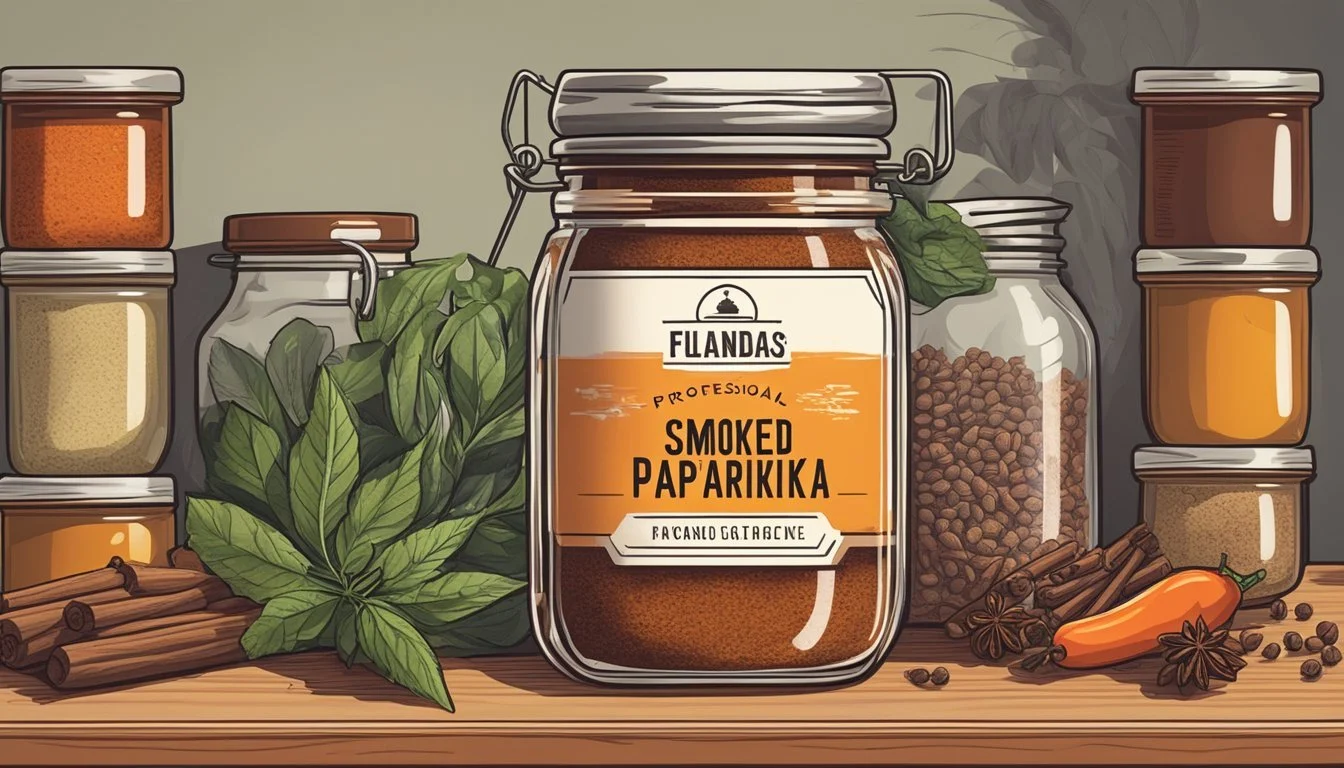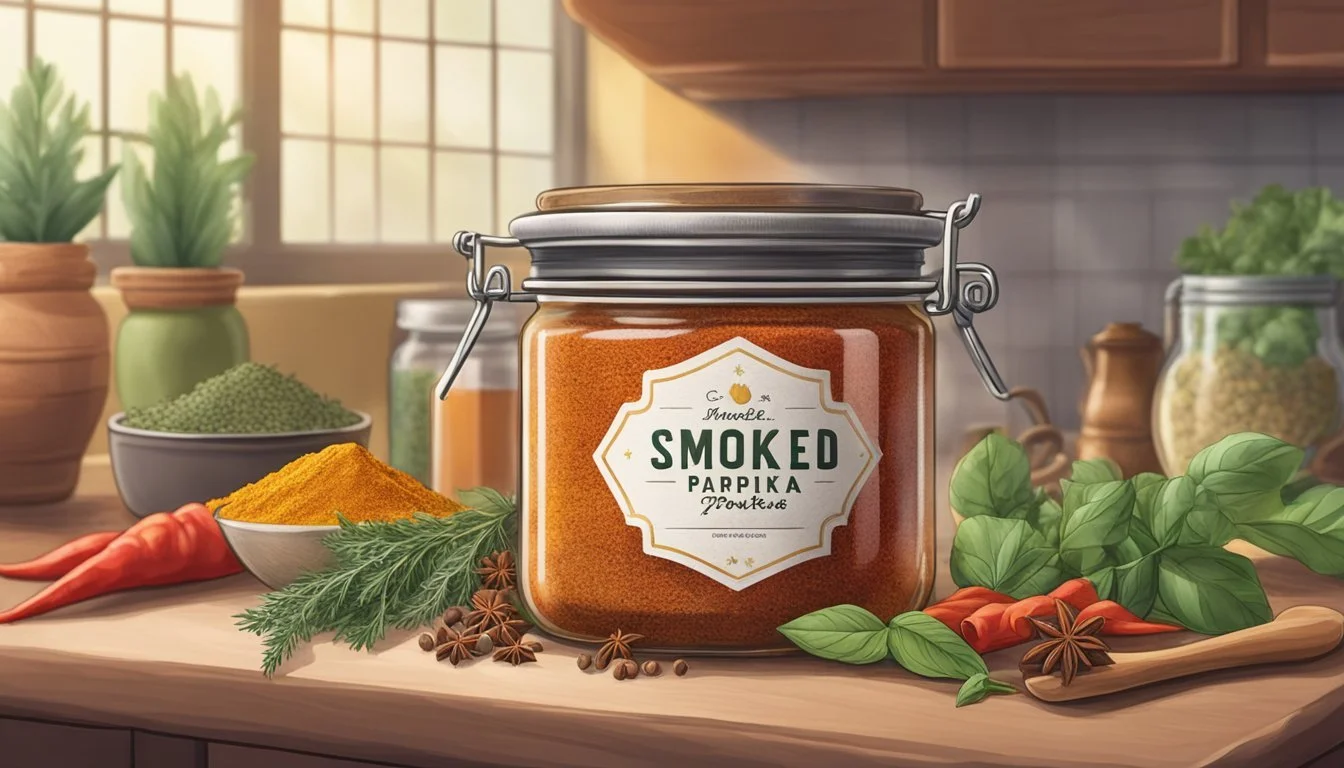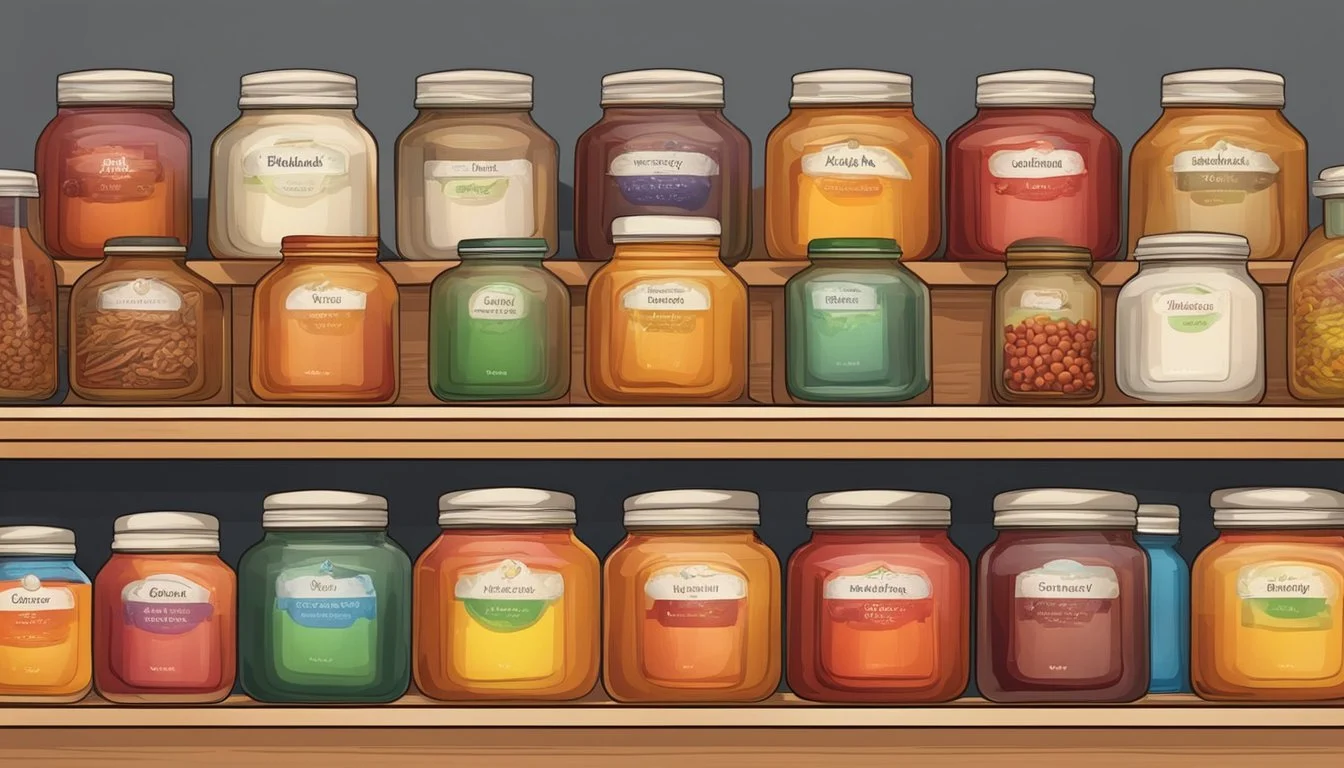Does Smoked Paprika Expire? Essential Storage Tips
Smoked paprika, a staple in many kitchens, offers a distinctive smoky flavor that enhances various dishes. For those wondering if this beloved spice expires, smoked paprika can indeed go bad, primarily by losing its potency over time. While it won't spoil like perishable foods, the vibrant color and aroma will diminish.
Proper storage is key to extending the shelf life of smoked paprika. Keeping it in a cool, dark place can help maintain its flavor longer. Some even recommend refrigeration to preserve its intensity.
Despite its long shelf life, signs such as an off smell, altered taste, or significant color change indicate it may be time to replace your smoked paprika. Following storage tips can ensure you always enjoy the best quality of this versatile spice.
The Basics of Smoked Paprika
Smoked paprika, derived from dried and smoked red peppers, brings a distinctive smoky flavor to culinary creations. This spice is integral to various dishes, enhancing their depth and richness.
Origin and Culinary Uses
Smoked paprika originates from Spain, prominently featured in Spanish cuisine. Known as Pimentón de La Vera, it is made by drying peppers over wood fires, which imparts its characteristic smoky taste.
This spice is widely used in chorizo, Spanish stews, and various meats. It also complements soups and vegetables, adding a deep, smoky flavor. Hungarian cuisine also uses paprika, though it is often sweet or hot rather than smoked.
Different Types: Sweet, Hot, and Smoked
Paprika comes in various types, each offering unique flavors. Sweet paprika is mild and often used for its vibrant color rather than heat.
Hot paprika adds a spicier kick, perfect for dishes needing more heat.
Smoked paprika, whether sweet or hot, is distinguished by its rich, smoky taste, making it a favorite in many savory dishes. These variations allow cooks to choose the perfect spice for their recipes, ensuring the desired flavor profile.
Shelf Life and Expiration
Smoked paprika, like many spices, has a varied shelf life depending on its storage conditions and form. Understanding how its potency changes over time can ensure you always enjoy its rich flavor.
Understanding Expiration Dates
The shelf life of smoked paprika can span several years but varies significantly. Ground smoked paprika generally maintains optimal quality for 2-4 years. Whole paprika may last up to 5 years.
Expiration dates often indicate peak freshness rather than safety. Best before dates suggest when the spice will be most flavorful. Using smoked paprika past its expiration date is not harmful, but its flavor and potency may diminish.
Factors Affecting Potency Over Time
Several factors influence how quickly smoked paprika loses its potency.
Storage conditions are crucial: keeping it in a cool, dark place maximizes its shelf life. Storing smoked paprika in an airtight container helps protect it from moisture and heat.
Refrigeration can extend its freshness to 6-12 months, whereas freezing can prolong its usability up to 2 years. Finally, signs like a change in color or off smell indicate it’s time to replace your smoked paprika.
Storage Fundamentals
Smoked paprika can maintain its flavor and potency with the right storage methods. By understanding the ideal storage conditions and avoiding common storage mistakes, you can prolong the shelf life of this vibrant spice.
Ideal Storage Conditions
Cool and Dry Environment: Smoked paprika should be stored in a cool, dark, and dry place to preserve its flavor. The ideal temperature is below 70°F (21°C). Excess heat and humidity can degrade its quality.
Airtight Containers: Use airtight containers to keep smoked paprika fresh. Glass jars or airtight plastic containers work well to prevent exposure to air and moisture.
Refrigeration and Freezing: For longer storage, consider refrigeration. Keeping smoked paprika in the refrigerator can extend its freshness for up to 12 months. Freezing can further prolong its usability up to 2 years, safeguarding the spice from heat and moisture.
Avoiding Common Storage Mistakes
Avoid Heat Sources and Sunlight: Store smoked paprika away from heat sources such as stoves and ovens. Direct sunlight can cause the spice to lose its color and flavor faster. A dark cupboard or a spice cabinet is ideal.
Prevent Moisture Exposure: Moisture can lead to clumping and spoilage. Always use dry spoons when scooping out smoked paprika. Storing it away from sinks and dishwashers helps to maintain its dryness.
Proper Labeling and Usage: Make it a habit to label your containers with the date of purchase. Rotate older stock to the front of your spice collection to ensure it is used before losing its potency. Avoid leaving the container open for extended periods to minimize air exposure.
By following these storage fundamentals, smoked paprika can be kept fresh and flavorful for extended periods, enhancing your culinary creations.
Spotting Signs of Degradation
Detecting signs of degradation in smoked paprika involves observing changes in color, sniffing for off smells, and noting any physical alterations such as clumping or the presence of mold. Paying attention to these aspects can help ensure that the paprika remains fresh and safe for consumption.
Visual Cues of Quality Loss
Fresh smoked paprika boasts a vivid red color, signaling its quality and potency. If the spice appears dull or brown, this indicates aging and potential spoilage. Such color changes are clear indicators that the paprika is likely past its prime.
Watch out for specks of white or grey, which could signify mold growth. In addition, excess moisture can lead to clumps, further indicating compromised quality.
Changes in Aroma and Taste
A fresh batch of smoked paprika should have a rich, smoky aroma. If the scent becomes faint or starts emitting an off smell, this suggests a loss of freshness and potency.
On tasting, the spice should deliver a robust flavor that complements your dishes. A lack of intensity or an altered taste are signs that the paprika is degrading. Always check both aroma and taste to assess the spice's quality.
Physical Changes: Clumping and Mold
Paprika should be free-flowing and dry. If it starts to clump together, it is usually a result of moisture exposure. This not only affects the spice's usability but is also a sign that its quality is deteriorating.
Mold formation is another serious issue. Any sign of mold, which may appear as fuzzy patches or white spots, means the paprika is bad and should be discarded immediately to avoid health risks. Keeping the spice in an airtight container helps prevent these physical changes.
Health and Safety Concerns
Smoked paprika, like any spice, can encounter specific health and safety issues. Apparent risks include contamination and loss of nutritional value due to aging. It’s crucial to know how to store it properly to maintain its quality.
Contamination Risks
Smoked paprika can be susceptible to bug contamination and mold growth, often as a result of improper storage conditions like high humidity. If not stored in a cool, dark, and dry place, the spice can attract insects or develop mold.
Mold on smoked paprika makes it unsuitable for consumption. Inspect the spice for unusual odor, color changes, or clumps indicating possible contamination. Keeping it in airtight containers can significantly reduce these risks.
Nutritional Value and Health Benefits
Smoked paprika contains essential nutrients such as Vitamin A and Vitamin E, which are vital for maintaining skin health and immune function. Despite its spice, it is low in calories and offers some capsaicin, which has anti-inflammatory properties.
Paprika's nutritional benefits decrease as it ages, primarily affecting its vitamin levels. Fresh paprika offers more potent health perks than old or expired ones. For the best benefits, aim to use smoked paprika within its first two to three years.
Extending Shelf Life
To extend the shelf life of smoked paprika, proper storage methods are crucial. Storing it correctly can significantly preserve its flavor and freshness.
Best Practices for Maximized Freshness
Smoked paprika should be stored in an airtight container to prevent moisture and air from degrading its quality. Refrigeration is an excellent option as the cool temperature slows down the degradation process, maintaining its robustness for 6 to 12 months.
If refrigeration isn't convenient, keeping the spice in a pantry is also effective. Ensure the pantry is cool and dark to maintain its freshness for about 3 to 6 months. For even longer preservation, freezing smoked paprika in a freezer bag can extend its usability for up to 2 years.
Culinary Tips and Alternatives
Smoked paprika enhances a variety of dishes with its rich, smoky flavor. Explore how to integrate it into meals and find alternatives when necessary.
Enhancing Dishes with Smoked Paprika
Smoked paprika adds depth to dishes. For stews and soups, it imparts a smoky nuance, enriching the broth. Sprinkle it on meats like chicken, pork, or beef before grilling or roasting to achieve a wood-fired taste.
In vegetable dishes, smoked paprika elevates the flavors, especially in roasted or sautéed recipes. It's a key ingredient in many sauces and marinades, bringing an extra layer of complexity.
If you need a substitute, consider using regular paprika mixed with a hint of cumin or chipotle powder for a similar smoky profile.
Understanding Paprika Varieties
Paprika comes in three primary types: sweet, hot, and smoked. Each variety offers unique flavors, making them suitable for different culinary uses. Their shelf lives and storage recommendations may also differ slightly.
Sweet, Hot, and Smoked Comparison
Sweet Paprika:
Sweet paprika, also known as Spanish paprika, has a mild and slightly sweet flavor. It is commonly used for adding color to dishes without adding heat. This variety is popular in Hungarian and Spanish cuisines. Stored properly, sweet paprika can retain its flavor for up to 2-3 years.
Hot Paprika:
Hot paprika is similar to sweet paprika but with added heat. It provides a spicy kick and is often used in dishes that require more spice. This type of paprika is frequently found in Hungarian cuisine. Proper storage can extend its shelf life to around 2-3 years.
Smoked Paprika:
Smoked paprika, often referred to as pimentón, is dried by smoking before grinding. This gives it a rich, smoky flavor distinct from other types. Common in Spanish dishes, smoked paprika can last longer than non-smoked varieties, especially if stored in a cooler environment like a refrigerator. Its flavor profile is unique and enhances many recipes.
Paprika in Cultural Contexts
Paprika not only adds flavor and color to dishes but also holds cultural significance in various cuisines. This section will explore the distinct role of paprika in Spanish and Hungarian culinary traditions.
Paprika's Role in Spanish and Hungarian Cuisine
Spanish Cuisine
In Spain, paprika is a key ingredient in many traditional recipes. Known locally as pimentón, it comes in several varieties, including sweet (dulce), bittersweet (agridulce), and hot (picante). Spanish paprika is essential in the making of chorizo, a popular type of sausage.
Spanish paprika is also used in dishes like paella and patatas bravas, both of which rely on the spice to provide depth and flavor.
Hungarian Cuisine
Hungary views paprika as a national treasure and culinary staple. Hungarian paprika is renowned for its rich flavor and vivid red color. It is classified into several types based on sweetness and heat, such as sweet (édes) and hot (csípős).
Paprika is indispensable in traditional dishes like goulash and paprikash. These dishes highlight the spice's ability to blend with other ingredients, creating a harmonious and robust flavor profile.
Substitute Spices and Seasonings
When smoked paprika is not available, various other spices and seasonings can be used to approximate its flavor and depth in dishes. Choosing the right alternative depends on the specific taste profile desired in the recipe.
Using Other Spices When Paprika is Unavailable
One effective substitute is chili powder, which provides a similar smoky and earthy flavor. While it may be spicier, adjusting the quantity can help achieve the desired taste.
Cumin and oregano can be combined to mimic smoked paprika. Cumin adds warmth and depth, whereas oregano offers a bit of herbal complexity. Use these spices in a 2:1 ratio to balance the flavors.
Cayenne pepper is another option but should be used sparingly due to its heat intensity. Mixing a small amount with garlic powder can create a tangy and spicy replacement.
For a less spicy alternative, a mix of thyme and garlic powder can work well. Thyme adds a subtle herbaceous note, while garlic powder provides a savory undertone. This mix is ideal for dishes where the smokiness of paprika isn't critical.
By using these spice combinations, the absence of smoked paprika won't hinder the overall flavor and complexity of your dishes. Adapt quantities to match your taste preferences.









